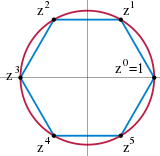数学上,一个给定集 上,所有到自身的可逆映射构成的集合关于映射的合成构成一个群,称为
上,所有到自身的可逆映射构成的集合关于映射的合成构成一个群,称为 的对称群,记为
的对称群,记为 。
。 的任一子群称为
的任一子群称为 上的变换群。
如果
上的变换群。
如果 是包含
是包含 个元素的有限集,称其到自身的可逆映射为
个元素的有限集,称其到自身的可逆映射为 阶置换(英语:permutation)。其对称群称为
阶置换(英语:permutation)。其对称群称为 阶对称群(英语:sysmmetric group of degree n),并把
阶对称群(英语:sysmmetric group of degree n),并把 记为
记为 。同时称
。同时称 的任一子群为置换群。[1]
的任一子群为置换群。[1]
置换群到被置换的元素的应用称为群作用;它在对称性和组合论以及数学的其他很多分支中有应用,也是研究晶体的结构等所不可或缺的工具。
置换通常写作轮换形式,例如,在轮换指标计算中,给定集合 ,
, 的一个置换
的一个置换 若为
若为 和
和 ,可以写作
,可以写作 ,或者更常见的写作
,或者更常见的写作 ,因为
,因为 保持不变;若对象有单个字母或数字表示,逗号也被省去,所以可以记作
保持不变;若对象有单个字母或数字表示,逗号也被省去,所以可以记作 。
。
常见的置换群[编辑]
 [编辑]
[编辑]

 [编辑]
[编辑]

 [编辑]
[编辑]




- John D. Dixon and Brian Mortimer. Permutation Groups. Number 163 in Graduate Texts in Mathematics. Springer-Verlag, 1996.
- Akos Seress. Permutation group algorithms. Cambridge Tracts in Mathematics, 152. Cambridge University Press, Cambridge, 2003.
- Meenaxi Bhattacharjee, Dugald Macpherson, Rögnvaldur G. Möller and Peter M. Neumann. Notes on Infinite Permutation Groups. Number 1698 in Lecture Notes in Mathematics. Springer-Verlag, 1998.
- Alexander Hulpke. GAP Data Library "Transitive Permutation Groups" (页面存档备份,存于互联网档案馆).
- ^ 韩士安,林磊. 近世代数(第二版). 北京: 科学出版社. 2009: 44. ISBN 9787030250612.





















